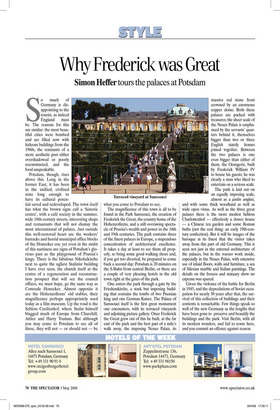Why Frederick was Great
Simon Heffer tours the palaces at Potsdam So much of Germany is disappointing to the tourist, as indeed England must be. The reasons for this are similar: the most beautiful cities were bombed and are filled now with hideous buildings from the 1960s, the remnants of a more aesthetic past either overshadowed or poorly reconstructed, and the food unspeakable.
Potsdam, though, rises above this. Long in the former East, it has been in the unified, civilised state long enough to have its cultural poten tial saved and redeveloped. The town itself has what the brown signs call a ‘historic centre’, with a café society in the summer, wide 18th-century streets, interesting shops and restaurants that will not dismay the most international of palates. Just outside this well-restored heart are the workers’ barracks and horrid municipal office blocks of the Honecker era; yet even in the midst of this nastiness are signs of Potsdam’s glorious past as the playground of Prussia’s kings. There is the fabulous Nikolaikirche next to quite the ugliest Stalinist building I have ever seen, the church itself at the centre of a regeneration and reconstruction prospect that will see the council offices, we must hope, go the same way as Comrade Honecker. Almost opposite it are the Hohenzollerns’ old stables, their magnificence perhaps appropriately used today as a film museum. Up the road is the Schloss Cecilienhof, where Stalin himself blagged much of Europe from Churchill, Attlee and Harry Truman. But although you may come to Potsdam to see all of these, they will not — or should not — be what you come to Potsdam to see.
The magnificence of this town is all to be found in the Park Sanssouci, the creation of Frederick the Great, the country home of the Hohenzollerns, and a still overawing spectacle of Prussia’s wealth and power in the 18th and 19th centuries. The park contains three of the finest palaces in Europe, a stupendous concentration of architectural excellence. It takes a day at least to see them all properly, so bring some good walking shoes and, if you get too diverted, be prepared to come back a second day: Potsdam is 20 minutes on the S-Bahn from central Berlin, or there are a couple of very pleasing hotels in the old town right at the gates of the park.
One enters the park through a gate by the Friedenskirche, a stark but imposing building that contains the tombs of two Prussian king and one German Kaiser. The Palace of Sanssouci itself is the first great monument one encounters, with its terraced vineyards and adjoining picture gallery. Once Frederick the Great grew out of this he built, at the far end of the park and the best part of a mile’s walk away, the imposing Neues Palais, its massive red stone front crowned by an enormous copper dome. Both these palaces are packed with treasures; the sheer scale of the Neues Palais is emphasised by the servants’ quarters behind it, themselves bigger than two or three English stately homes joined together. Between the two palaces is one even bigger than either of them, the Orangerie, built by Frederick William IV to house his guests; he was clearly a man who liked to entertain on a serious scale.
The park is laid out on an equally imposing scale, almost as a jardin anglais, and with some thick woodland as well as wide open vistas. As well as the three great palaces there is the more modest Schloss Charlottenhof — effectively a dower house — a Chinese tea garden and some Roman baths (not the real thing: an early 19th-century confection). But it will be images of the baroque at its finest that the visitor takes away from this part of old Germany. This is seen not just in the external architecture of the palaces, but in the rococo work inside, especially in the Neues Palais, with extensive use of inlaid floors, walls and furniture, a sea of Silesian marble and Italian paintings. The details on the frescos and statuary show no expense was spared.
Given the violence of the battle for Berlin in 1945, and the depredations of Soviet occupation for nearly 50 years after that, the survival of this collection of buildings and their contents is remarkable. Few things speak so well of the new Germany as the lengths that have been gone to preserve and beautify the buildings and the park. Visit Berlin, with all its modern wonders, and fail to come here, and you commit an offence against reason.


















































































 Previous page
Previous page